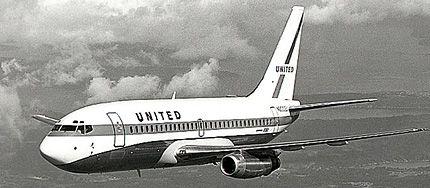|
|||||||||||||||||
|
|
|
|||
|
|
||||
 |
United Airlines traces its claim to be the oldest commercial airline in
the
Varney's chief pilot, Leon D. "Lee" Cuddeback, flew the first Contract
Air Mail flight in a Swallow biplane from Varney's headquarters in |
|||
|
April 6 is regarded in the United Airlines company history as both its
own birthday and the date on which "true" airline service operating on
fixed routes and fixed schedules began in the United States.
Varney Airlines' original 1925 hangar served as a portion of the
terminal building for the In 1927, airplane pioneer William Boeing founded his own airline, Boeing Air Transport, and began buying other airmail carriers, including Varney's. Within four years, Boeing's holdings grew to include airlines, airplane and parts manufacturing companies, and several airports. In 1929, the company changed its name to United Aircraft and Transport Corp. (UATC).
In 1930,
as the capacity of airplanes proved sufficient to carry not only mail
but also passengers, Boeing Air Transport hired a registered nurse,
Ellen Church, to assist passengers. United claims Church as the first
airline stewardess. On May 7, 1930, UATC completed the acquisition of
National Air Transport Inc, a large carrier based in
Following the Air Mail scandal of 1930, the Air Mail Act of 1934 banned
the common ownership of manufacturers and airlines. UATC's President
Philip G. Johnson was forced to resign and moved to Trans-Canada
Airlines, the future Air
|
||||
|
On the night of October 11, 1933, a United Boeing 247 exploded in
mid-air and crashed near
During World War II, United-trained ground crews modified airplanes for
use as bombers, and transported mail, material, and passengers in
support of the war effort. Post-war United benefited from both the
wartime development of new airplane technologies (like the pressurized
cabin which permitted planes to fly above the weather) and a boom in
customer demand for air travel. This was also the period in which Pan
American Airways established a
On November 1, 1955, United Airlines Flight 629, which was flying from
Stapleton Airport in Denver to Portland, Oregon, was bombed, killing
everyone on board the Douglas DC-6B aircraft. The bomb was planted by
Jack Graham who placed the device in his mother's luggage with the
intent of collecting on her life insurance policy. Graham was arrested,
tried, and was executed a year after the explosion. United merged with
Capital Airlines on June 1, 1961, making it the world's largest
commercial airline and giving it a route network covering the entire
United States.
United Airlines has the distinction of being the only commercial airline
to have operated Executive One, the designation given to a civilian
flight which the U.S. President is aboard. On December 23, 1973, then
President Richard Nixon flew as a passenger aboard a United DC-10 flight
from Washington Dulles to
United had begun to seek overseas routes in the 1960s, but the
Transpacific Route Case (1969) denied them this expansion. It did not
gain an overseas route until 1983, when they began flights to
Economic turmoil, labor unrest, and the pressures of the 1978 Airline
Deregulation Act greatly affected the company, which incurred losses and
saw a greatly increased turnover in its senior management through the
1970s and early 1980s.
On May 17, 1985, United's pilots went on a 29-day strike claiming the
CEO, Richard Ferris, was trying to "break the unions." They used
management's proposed "B-scale" pilot pay rates as proof. American
Airlines already had a non-merging B-scale for its pilots. Ferris
insisted United had to have pilot costs no higher than American's, so he
offered United pilots a "word-for-word" contract to match American's, or
the same bottom line numbers. The United ALPA-MEC rejected that offer.
The only choice left, to achieve parity with American's pilot costs, was
to begin a B-scale for United's new-hire pilots.
Ferris wanted that B-scale to merge in the captain's ranks, which was more generous than American's B-scale, that never merged at all. But, the ALPA MEC insisted they merge in the new pilot's sixth-year with the airline. In the final hours before the strike, nearly all issues had been resolved, except for the time length of the B-scale. It appeared that would be resolved too as negotiations continued. ALPA negotiators delivered a new counter-proposal at 12:20 A.M. in an effort to avoid the strike. |
||||||
|
||||||
|
|
||||||
| ?AvStop
Online Magazine
Contact
Us
Return To News
|
||||||
|

